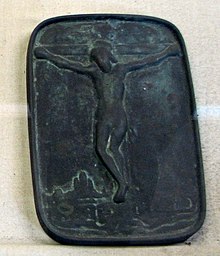You can help expand this article with text translated from the corresponding article in Japanese. (December 2022) Click for important translation instructions.
|


A fumi-e (踏み絵, fumi "stepping-on" + e "picture") was a likeness of Jesus or Mary onto which the religious authorities of the Tokugawa shogunate of Japan required suspected Christians (Kirishitan) to step, in order to demonstrate that they were not members of the outlawed religion; otherwise they would be tortured or killed.
History

Fumi-e began first to be used against Christians in Nagasaki in 1629. Residents of Nagasaki, whether commoner, Buddhist monk or samurai, were required to tread on the icons which were brought from house to house. Their use was officially abandoned when ports opened to foreigners on 13 April 1856, but some remained in use until Christian teaching was placed under formal protection during the Meiji era. The icons were also known as e-ita or ita-e, while the forced test was called "e-fumi".
The Japanese government used the e-fumi to uncover Christians and sympathizers. Fumi-e contained images of the Virgin Mary and Jesus, which government officials ordered all to trample on. Those who were reluctant or refused to do so were arrested for being Christians. The policy of the shogunate was to get them to abjure the faith. If they refused they would be tortured. If they still refused to abjure, they would be killed. Some executions took place at Nagasaki's Mount Unzen, where the Christians were boiled in the hot springs.
Execution for Christianity was unofficially abandoned by the Tokugawa Shogunate in 1805.
Eighteenth-century Europe was aware enough of e-fumi for authors of fiction to mention it when alluding to Japan, as in Jonathan Swift's Gulliver's Travels (1726), Oliver Goldsmith's The Citizen of the World (1760), and Voltaire's Candide (1759). Allegations published in Europe during the late 17th and early 18th century that Dutch traders at Dejima were required to undergo the e-fumi are thought by modern scholars to be propaganda arising from the Anglo-Dutch Wars.
In modern Japanese literature, treading on the fumi-e is a pivotal plot element of the novel Silence by Shūsaku Endō and the 2016 film of the same name.
Christians would sometimes perform the e-fumi yet continue to practice their beliefs secretly (Kakure Kirishitan); there were some 20,000 secret Christians in Japan when Christianity was legalized again, down from 500,000 in Nagasaki at the height of Japanese Christianity before the persecution. University of Auckland professor Mark Mullins concluded that "In that sense, the fumi-e policies were effective."
Interpretations
Many theologians have tried to contemplate the role of the fumi-e to Japanese Christians, some seeing the treading of the fumi-e as a sign of the love and forgiveness of Jesus Christ.
Nagasaki Junshin Catholic University professor Simon Hull stated that if all of the fumi-e participants had instead chosen to be defiant and died, Christianity would not have continued in Japan; he stated "It is only because some made an existential decision to trample on the fumi-e, ... that Christianity in Japan was able to survive."
Form
Fumi-e were usually cast from bronze, but others were made of painted stone and some were woodblock prints. There are relatively few surviving fumi-e, as most were simply thrown away or recycled for other uses. Some examples were displayed by the Smithsonian in their 2007 exhibition "Encompassing the Globe: Portugal and the World in the 16th and 17th Centuries."
See also
References
- Shunkichi Akimoto (1961). Exploring the Japanese Ways of Life. Tokyo News Service. p. 233. Retrieved 21 November 2011.
Attached to this word is an exotic, foreignized sort of interest though it was a native invention of the early Yedo Period and had remained a curious symbol of the anti-Christian policy of the Tokugawa feudalism.
- Tan, Yvette (24 November 2019). "The Japanese Christians forced to trample on Christ". BBC News. Retrieved 29 April 2022.
- ^ Kaufmann, Thomas DaCosta (2004). Toward a Geography of Art. University of Chicago Press. p. 308. ISBN 9780226133119.
- Bradley K. Martin (19 December 1980). "Japanese Christian Group Keeps Relics of Old Faith in the Closet". Los Angeles Times. p. C1.
A government office devised a test called fumi-e...
- David E. Sanger (7 June 1991). "Volcano's Fury Turns a Shrine Into a Morgue". The New York Times. Retrieved 6 December 2015.
- Jonathan Swift (1726). "Part III. A Voyage to Laputa, Balnibarbi, Luggnagg, Glubbdubdrib, and Japan. Chapter 11". Gulliver's Travels.
To this I added another petition, that for the sake of my patron the king of Luggnagg, his majesty would condescend to excuse my performing the ceremony imposed on my countrymen, of trampling upon the crucifix: because I had been thrown into his kingdom by my misfortunes, without any intention of trading. When this latter petition was interpreted to the Emperor, he seemed a little surprised; and said, he ... suspected I must be a Christian...
- ^ Michael North (2010). Michael North (ed.). Artistic and Cultural Exchanges Between Europe and Asia, 1400–1900: Rethinking Markets, Workshops and Collections. Ashgate Publishing. p. 141. ISBN 9780754669371.
- Gardiner, Anne Barbeau (Summer 1991). "Swift on the Dutch East India Merchants: The Context of 1672-73 War Literature". Huntington Library Quarterly. 54 (3): 234–252. doi:10.2307/3817708. JSTOR 3817708.
- William T. Cavanaugh (1998). "The god of silence: Shusaku Endo's reading of the Passion". Commonweal. Retrieved 25 November 2011.
- Jeff Keuss (March 2007). "The Lenten Face of Christ in Shusaku Endo's Silence and Life of Jesus". Expository Times. 118 (6): 273–279. doi:10.1177/0014524606076087. S2CID 170461263. Retrieved 25 November 2011.
- ^ Tan, Yvette (24 November 2019). "The Japanese Christians forced to trample on Christ". BBC. Retrieved 24 November 2019.
- e.g. Masao Takenaka: When the Bamboo Bends, Christ and Culture in Japan, WCC 2002 pgs 50-51
- Jenkins, Mark (20 July 2007). "Portugal's Unending Sphere of Influence". The Washington Post. Retrieved 21 November 2011.
- Michael Fragoso (11 July 2007). "Fair Trade with 17th-Century Portugal". The American. Archived from the original on 3 October 2013. Retrieved 21 November 2011.